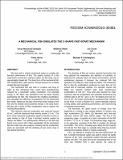| dc.contributor.author | Modarres-Sadeghi, Yahya | |
| dc.contributor.author | Watts, Matthew Nicholas | |
| dc.contributor.author | Conte, Joseph R. | |
| dc.contributor.author | Hover, Franz S | |
| dc.contributor.author | Triantafyllou, Michael S | |
| dc.date.accessioned | 2019-01-09T18:24:37Z | |
| dc.date.available | 2019-01-09T18:24:37Z | |
| dc.date.issued | 2010-08 | |
| dc.identifier.isbn | 978-0-7918-5451-8 | |
| dc.identifier.uri | http://hdl.handle.net/1721.1/119886 | |
| dc.description.abstract | We have built a simple mechanical system to emulate the fast-start performance of fish. The system consists of a thin metal beam covered by a urethane rubber, the fish body, and an appropriately shaped tail. The body form of the mechanical fish was modeled after a pike species, selected because it is a widely studied fast-start specialist. The mechanical fish was held in curvature and hung in water by two restraining lines, which were simultaneously released by a pneumatic cutting mechanism. The potential energy in the beam was transferred into the fluid, thereby accelerating the fish. We measured the resulting acceleration, and calculated the efficiency of propulsion for the mechanical fish model, defined as the ratio of the final kinetic energy of the fish and the initially stored potential energy in the body beam. We also ran a series of flow visualization tests to observe the resulting flow patterns. The maximum start-up acceleration was measured around 40 ms[superscript -2], with the maximum final velocity around 1.2 ms[superscript -1]. The form of the measured acceleration signal as function of time is quite similar to that of Type I fast-start motions studied by Harper and Blake. The hydrodynamic efficiency of the fish was found to be around 10%. Flow visualization of the mechanical fast-start wake was also analyzed, showing that the acceleration peaks are associated with the shedding of two vortex rings in near-lateral directions. Topics: Shapes , Mechanisms | en_US |
| dc.publisher | ASME International | en_US |
| dc.relation.isversionof | http://dx.doi.org/10.1115/FEDSM-ICNMM2010-30381 | en_US |
| dc.rights | Article is made available in accordance with the publisher's policy and may be subject to US copyright law. Please refer to the publisher's site for terms of use. | en_US |
| dc.source | ASME | en_US |
| dc.title | A Mechanical Fish Emulates the C-Shape Fast-Start Mechanism | en_US |
| dc.type | Article | en_US |
| dc.identifier.citation | Modarres-Sadeghi, Yahya, Matthew Watts, Joe Conte, Franz Hover, and Michael S. Triantafyllou. “A Mechanical Fish Emulates the C-Shape Fast-Start Mechanism.” ASME 2010 7th International Symposium on Fluid-Structure Interactions, Flow-Sound Interactions, and Flow-Induced Vibration and Noise: Volume 3, Parts A and B, 1-5 August, 2010, Montreal, Quebec, Canada, ASME, 2010. © 2010 by ASME | en_US |
| dc.contributor.department | Massachusetts Institute of Technology. Department of Mechanical Engineering | en_US |
| dc.contributor.mitauthor | Modarres-Sadeghi, Yahya | |
| dc.contributor.mitauthor | Watts, Matthew Nicholas | |
| dc.contributor.mitauthor | Conte, Joseph R. | |
| dc.contributor.mitauthor | Hover, Franz S | |
| dc.contributor.mitauthor | Triantafyllou, Michael S | |
| dc.relation.journal | ASME 2010 7th International Symposium on Fluid-Structure Interactions, Flow-Sound Interactions, and Flow-Induced Vibration and Noise: Volume 3, Parts A and B | en_US |
| dc.eprint.version | Final published version | en_US |
| dc.type.uri | http://purl.org/eprint/type/ConferencePaper | en_US |
| eprint.status | http://purl.org/eprint/status/NonPeerReviewed | en_US |
| dc.date.updated | 2019-01-04T18:37:58Z | |
| dspace.orderedauthors | Modarres-Sadeghi, Yahya; Watts, Matthew; Conte, Joe; Hover, Franz; Triantafyllou, Michael S. | en_US |
| dspace.embargo.terms | N | en_US |
| dc.identifier.orcid | https://orcid.org/0000-0002-7890-1699 | |
| dc.identifier.orcid | https://orcid.org/0000-0002-2621-7633 | |
| dc.identifier.orcid | https://orcid.org/0000-0002-4960-7060 | |
| mit.license | PUBLISHER_POLICY | en_US |
